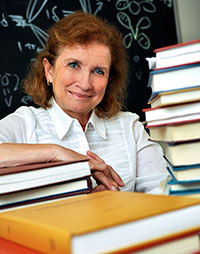
Marcetta Darensbourg
Distinguished Professor
Davidson Chair in Science
Bio-inspired Catalysts for Hydrogen Production: The ultimate, home-run, goal of our work is to synthesize and develop a robust, highly active hydrogen-producing catalyst comprised of earth-abundant transition metals within a ligand environment that is inspired by the biological Figure 3hydrogenase (H2ase) enzyme active sites. Progress in precise structural modeling of the illusive "rotated" structure displayed in the as-isolated, mixed-valent FeIIFe state in the past decade has permitted in depth analysis of electronic structure by Mö ssbauer, EPR (ENDOR), and computational chemistry. We can conclude why this unique organometallic structure, first spotted in biology (but now achieved by distinct but convergent synthetic strategies in three laboratories) is stable! The square pyramid-inverted square pyramid structures result from sufficient disruption of Fe—Fe bond order in the FeIFeI precursors that permits steric factors to dominate and enforce rotation of one square pyramid relative to the other.
Still, questions remain regarding functional matches: the need for two metals in the [FeFe]- and [NiFe]-H2ase active sites; whether additional collaborative redox activity is required; or whether innocent metallodithiolate ligands control the redox levels of a single metal site. These questions are being addressed by analysis of advanced synthetic analogues that have evolved from 1st and 2nd generation electrocatalysts, and, in collaborations, by comparison to spectroscopic signals from the [FeFe]-H2ase active site.
New electrocatalysts for hydrogen production: The connection between the Fe(NO)2 unit and the Fe(CX)3 (X = O or N) unit found in hydrogenase enzyme active sites offers opportunity for design of new catalysts, one of which is shown. In this regard we explore the ability of N2S2 metal complexes to bind as metallodithiolate ligands to various metal acceptors. The properties of such complexes vary The connection of these to light harvesting molecules for dye sensitized, sacrificial electron donor, hydrogen production is also of interest.
When Iron Meets Nitric Oxide: Good Chemistry, Intriguing Biology. The affinity of iron for diatomic molecules, O2, CO, N2, and NO, is central to the most important of life processes, including those of human physiology. Figure 6In this research area we target synthetic chemistry involving dinitrosyl iron complexes (DNICs) that serve as biomimetics of products of FeS cluster degradation by excesses of NO, or as derived from the chelatable iron pool (CIP) in cells. The electronic ambivalence of the DNIC unit is expressed in the ease with which it interconverts between oxidized and reduced forms, {Fe(NO)2}9 and {Fe(NO)2}10, respectively (Enemark/Feltham notation), and serves as impetus to explore analogous reactions known to involve the CuII/CuI redox couple. The accessory ligands which stabilize one redox level over the other, including N-heterocyclic carbenes as histidine mimics, and properties of DNIC derivatives are explored.
B. S., 1963, Union College Kentucky
Ph. D., 1967, University of Illinois at Urbana